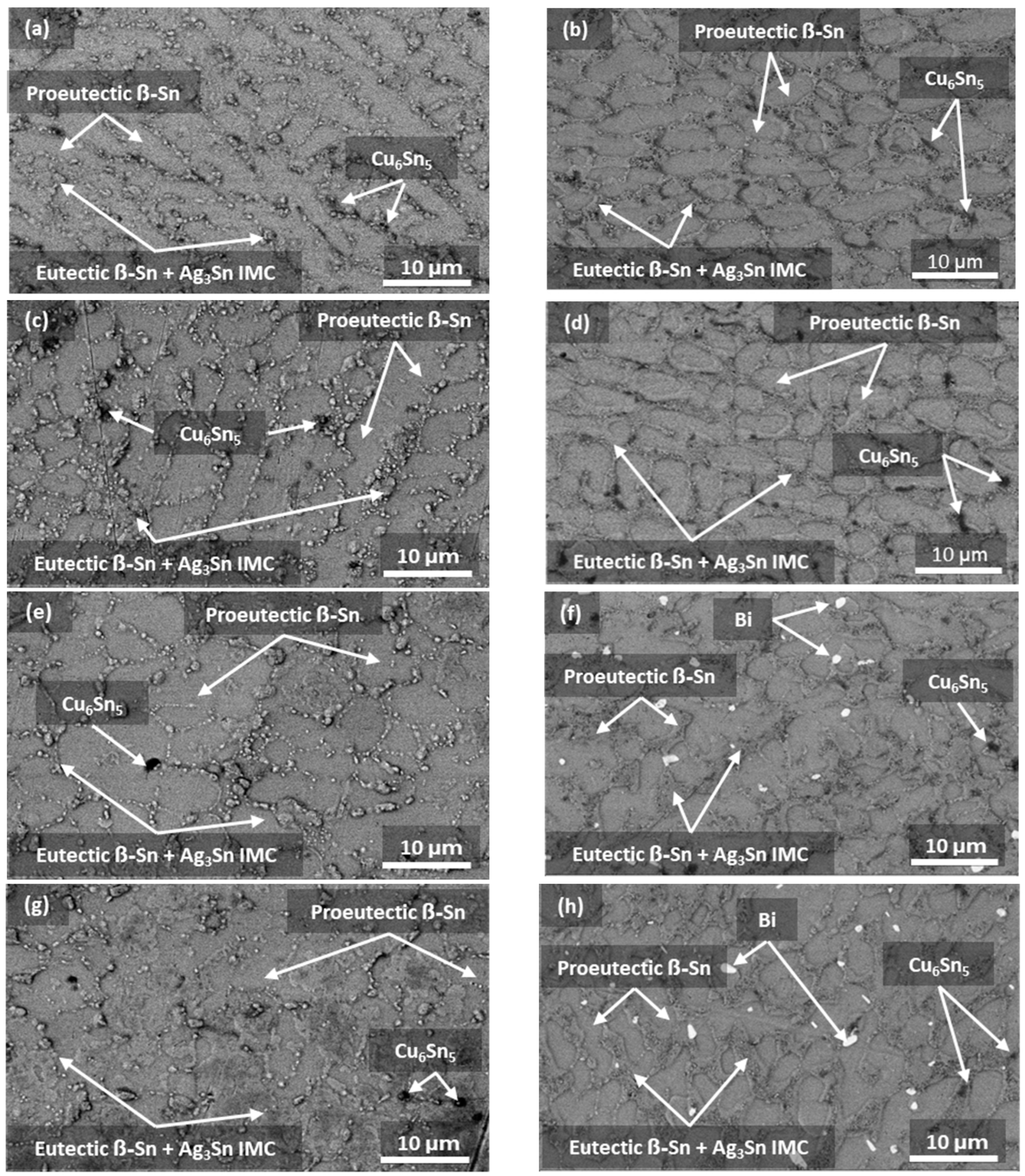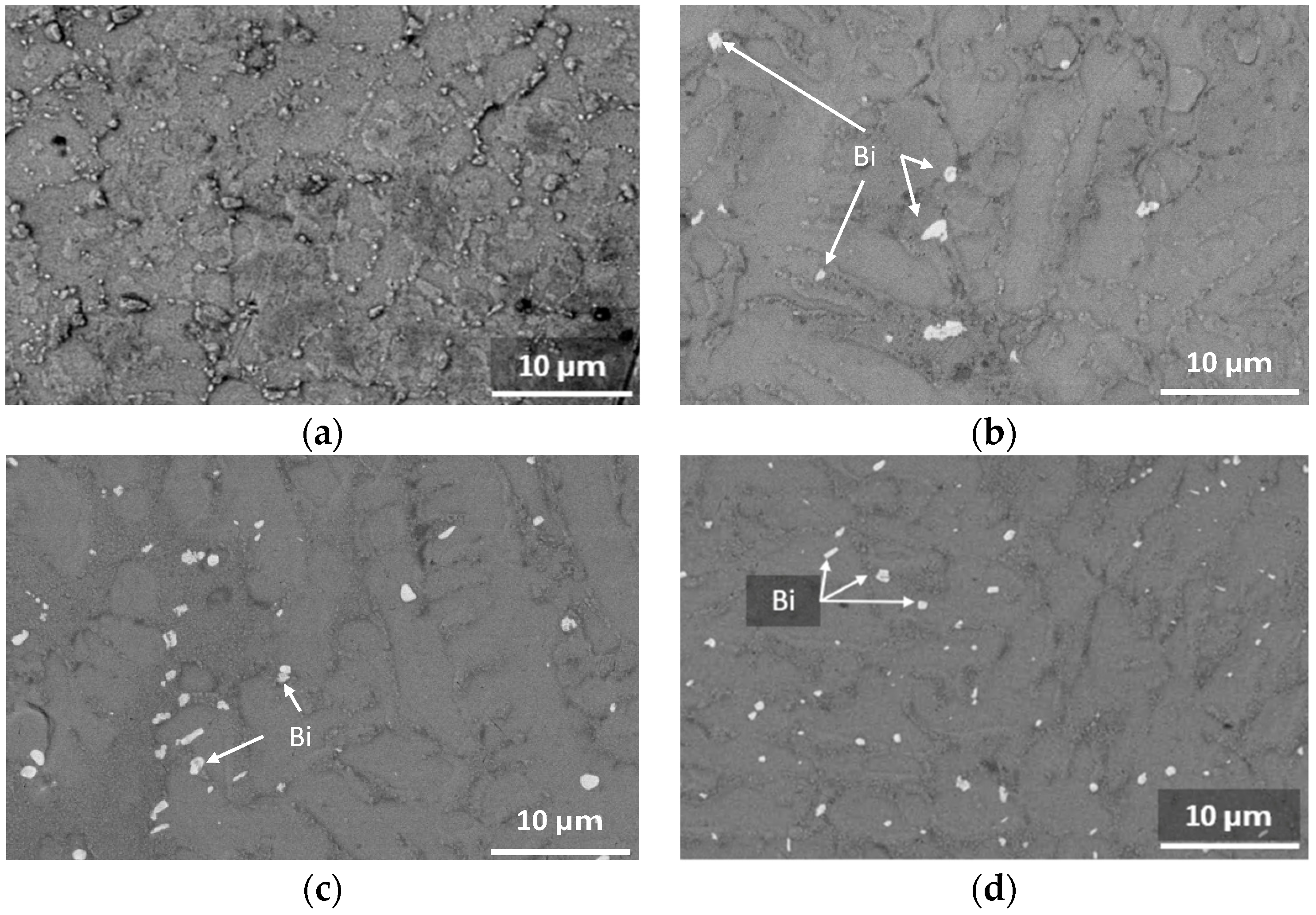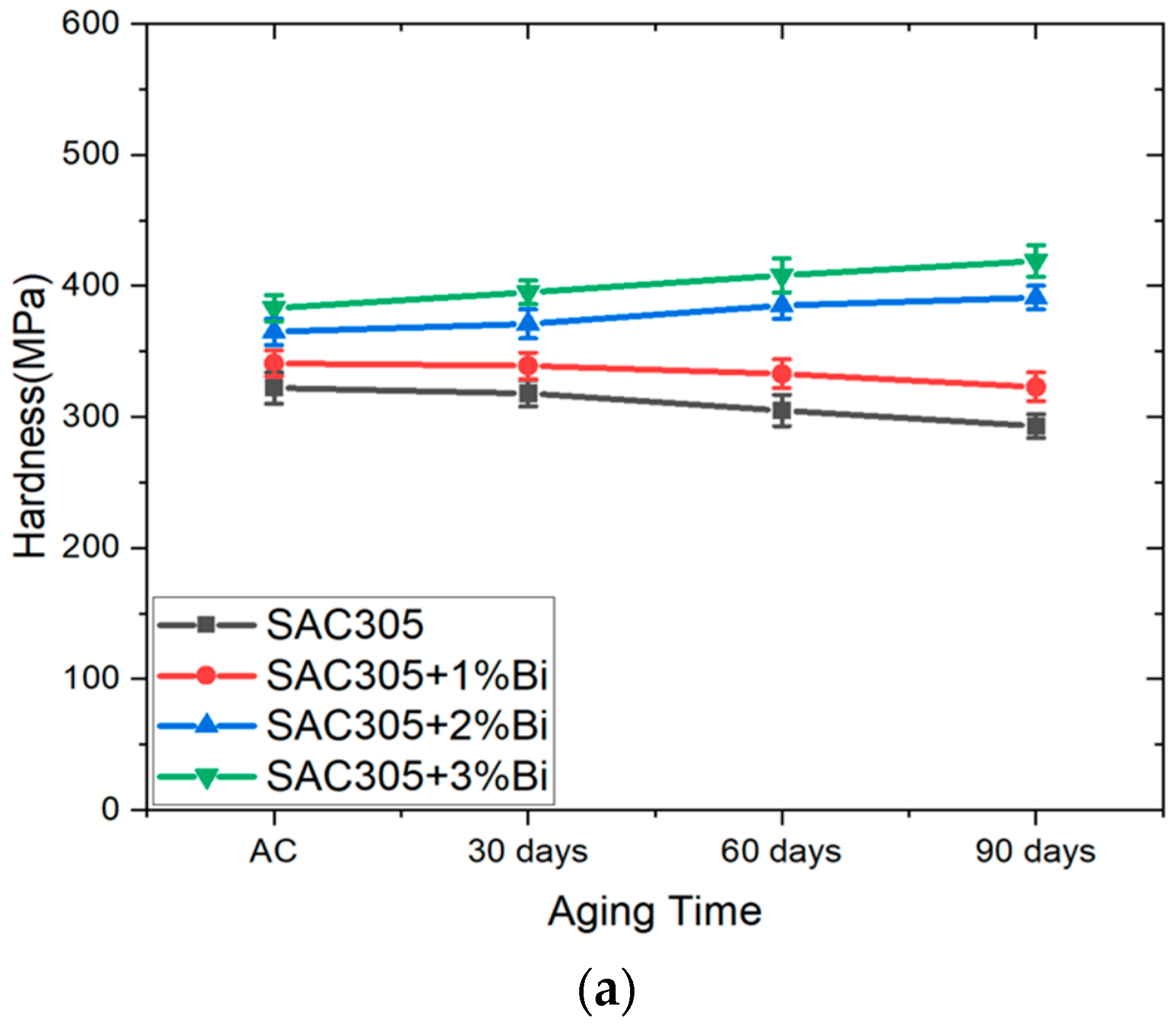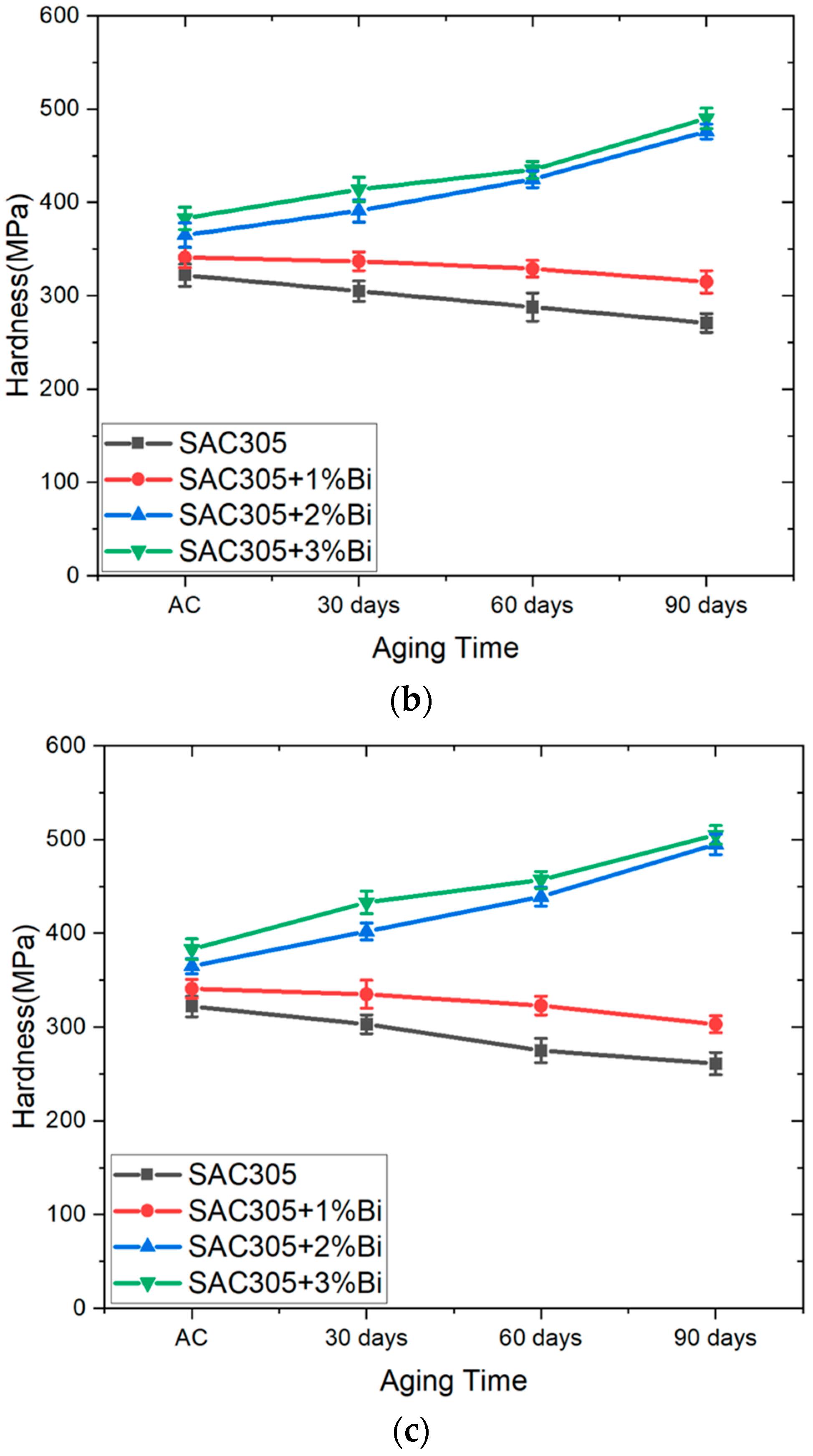Reliability Risk Mitigation in Advanced Packages by Aging-Induced Precipitation of Bi in Water-Quenched Sn–Ag–Cu–Bi Solder
Abstract
1. Introduction
2. Materials and Methods
- A.
- Sample Preparation
- B.
- Aging Experiment
- C.
- Investigation of Microstructures
- D.
- Measurement of Hardness and Creep Strength
3. Results
- A.
- Microstructural Evolution
- B.
- Hardness
- C.
- Creep Strength
4. Discussion
5. Conclusions
Author Contributions
Funding
Institutional Review Board Statement
Informed Consent Statement
Data Availability Statement
Acknowledgments
Conflicts of Interest
References
- Abtew, M.; Selvaduray, G. Lead-free Solders in Microelectronics. Mater. Sci. Eng. 2000, 27, 95–141. [Google Scholar] [CrossRef]
- Ogunseitan, O. Public health and environmental benefits of adopting lead-free solders. J. Miner. Met. Mater. Soc. 2007, 59, 12–17. [Google Scholar] [CrossRef]
- Clech, J. Lead-Free Solder Joint Reliability. In Lead Free Soldering; Bath, J., Ed.; Springer: Boston, MA, USA, 2007; pp. 145–172. [Google Scholar] [CrossRef]
- Zhang, L.; He, C.; Guo, Y.; Han, J.; Zhang, Y.; Wang, X. Development of SnAg-based lead free solders in electronics packaging. Microelectron. Reliab. 2012, 52, 559–578. [Google Scholar] [CrossRef]
- Sonawane, P.; Raja, V.; Palanikumar, K.; Kumar, E.; Aditya, N.; Rohit, V. Effects of gallium, phosphorus and nickel addition in lead-free solders: A review. Mater. Today Proc. 2021, 46, 3578–3581. [Google Scholar] [CrossRef]
- Peng, Y.; Li, C.; Xiao, K.; Yang, J.; Pu, C.; Gao, P.; Guo, S.; Zhang, J.; Yi, J. Effects of Ga alloying on microstructure and comprehensive performances of Sn–9Zn–2Bi alloys for the microelectronics industry. Microelectron. Reliab. 2022, 135, 114599. [Google Scholar] [CrossRef]
- Jayaram, V.; Gupte, O.; Bhangaonkar, K.; Nair, C. A Review of Low-Temperature Solders in Microelectronics Packaging. IEEE Trans. Compon. Packag. Manuf. Technol. 2023, 13, 570–579. [Google Scholar] [CrossRef]
- Cheng, S.; Huang, C.; Pecht, M. A review of lead-free solders for electronics applications. Microelectron. Reliab. 2017, 75, 77–95. [Google Scholar] [CrossRef]
- Wang, X.; Zhang, L.; Li, M. Microstructure and properties of Sn-Ag and Sn-Sb lead-free solders in electronics packaging: A review. J. Mater Sci. Mater. Electron. 2022, 33, 2259–2292. [Google Scholar] [CrossRef]
- Morando, C.; Fornaro, O.; Garbellini, O.; Palacio, H. Thermal properties of Sn-based solder alloys. J. Mater. Sci. Mater. Electron. 2014, 25, 3440–3447. [Google Scholar] [CrossRef]
- Dele-Afolabi, T.; Ansari, M.; Hanim, M.; Oyekanmi, A.; Ojo-Kupoluyi, O.; Atiqah, A. Recent advances in Sn-based lead-free solder interconnects for microelectronics packaging: Materials and technologies. J. Mater. Res. Technol. 2023, 25, 4231–4263. [Google Scholar] [CrossRef]
- Nguyen, T.; Yu, D.; Park, S. Characterizing the Mechanical Properties of Actual SAC105, SAC305, and SAC405 Solder Joints by Digital Image Correlation. J. Electron. Mater. 2011, 40, 1409–1415. [Google Scholar] [CrossRef]
- Kumar, P.; Gergely, G.; Horvath, D.; Gacsi, Z. Investigating the microstructural and mechanical properties of pure lead-free soldering materials (SAC305 & SAC405). Powder Metall. Prog. 2018, 18, 49–57. [Google Scholar] [CrossRef]
- Siewiorek, A.; Kudyba, A.; Sobczak, N. Effects of PCB Substrate Surface Finish and Flux on Solderability of Lead-Free SAC305 Alloy. J. Mater. Eng. Perform. 2013, 22, 2247–2252. [Google Scholar] [CrossRef][Green Version]
- Abueed, M.; Athamneh, R.; Tanash, M.; Hamasha, S. The Reliability of SAC305 Individual Solder Joints during Creep–Fatigue Conditions at Room Temperature. Crystals 2022, 12, 1306. [Google Scholar] [CrossRef]
- Dusek, K.; Vesely, P.; Busek, D.; Petrac, A.; Geczy, A.; Illes, B.; Krammer, O. Influence of Flux and Related Factors on Intermetallic Layer Growth within SAC305 Solder Joints. Materials 2021, 14, 7909. [Google Scholar] [CrossRef]
- Su, S.; Akkara, F.; Abueed, M.; Jian, M.; Hamasha, S.; Suhling, J.; Lall, P. Fatigue Properties of Lead-free Doped Solder Joints. In Proceedings of the 2018 17th IEEE Intersociety Conference on Thermal and Thermomechanical Phenomena in Electronic Systems (ITherm), San Diego, CA, USA, 29 May–1 June 2018; pp. 1243–1248. [Google Scholar] [CrossRef]
- Fu, N.; Wu, J.; Ahmed, S.; Suhling, J.; Lall, P. Investigation of Aging Induced Evolution of the Microstructure of SAC305 Lead Free Solder. In Proceedings of the ASME 2017 International Technical Conference and Exhibition on Packaging and Integration of Electronic and Photonic Microsystems, San Francisco, California, USA, 29 August–1 September 2017; p. 74266. [Google Scholar] [CrossRef]
- Wu, J.; Ahmed, S.; Suhling, J.; Lall, P. Investigation of Aging Induced Microstructural Changes in Doped SAC+X Solders. In Proceedings of the 2019 18th IEEE Intersociety Conference on Thermal and Thermomechanical Phenomena in Electronic Systems (ITherm), Las Vegas, NV, USA, 28–31 May 2019; pp. 405–415. [Google Scholar] [CrossRef]
- Shukla, V.; Ahmed, O.; Jalilvand, G.; Mehta, A.; Su, P.; Jiang, T. Effects of Aging on Microstructure and Mechanical Properties of Sn-Ag-Cu-Bi Solder Alloys. In Proceedings of the 2021 IEEE 71st Electronic Components and Technology Conference (ECTC), San Diego, CA, USA, 1 June–4 July 2021; pp. 667–672. [Google Scholar] [CrossRef]
- Hasnine, M.; Suhling, J.; Prorok, B.; Bozack, J.; Lall, P. Exploration of aging induced evolution of solder joints using nanoindentation and microdiffraction. In Proceedings of the 2014 IEEE 64th Electronic Components and Technology Conference (ECTC), Orlando, FL, USA, 27–30 May 2014; pp. 379–394. [Google Scholar] [CrossRef]
- Chantaramanee, S.; Sungkhaphaitoon, P. Influence of bismuth on microstructure, thermal properties, mechanical performance, and interfacial behavior of SAC305-xBi/Cu solder joints. Trans. Nonferrous Met. Soc. China 2021, 31, 1397–1410. [Google Scholar] [CrossRef]
- Ahmed, S.; Suhling, J.; Lall, P. The Anand parameters of aging resistant doped solder alloys. In Proceedings of the 2017 16th IEEE Intersociety Conference on Thermal and Thermomechanical Phenomena in Electronic Systems (ITherm), Orlando, FL, USA, 30 May–2 June 2017; pp. 1416–1424. [Google Scholar] [CrossRef]
- Athamneh, R.; Hamasha, S. Fatigue Behavior of SAC-Bi and SAC305 Solder Joints With Aging. IEEE Trans.Compon. Packag. Manuf. Technol. 2020, 10, 611–620. [Google Scholar] [CrossRef]
- Belhadi, M.; Hamasha, S.; Alahmer, A. Effect of Bi content and aging on solder joint shear properties considering strain rate. Microelectron. Reliab. 2023, 146, 115020. [Google Scholar] [CrossRef]
- Belhadi, M.; Akkara, F.; Athamenh, R.; Abueed, M.; Hamasha, S.; Ali, H.; Suhling, J.; Lall, P. The Effect of Bi on the Mechanical Properties of Aged SAC Solder Joint. In Proceedings of the 2020 19th IEEE Intersociety Conference on Thermal and Thermomechanical Phenomena in Electronic Systems (ITherm), Orlando, FL, USA, 21–23 July 2020; pp. 1100–1105. [Google Scholar] [CrossRef]
- Shukla, V.; Ayers, N.; Moreno, A.; Crutchfield, N.; Lyons, D.; Ahmed, O.; Su, P.; Glasauer, B.; Jiang, T. The Effects of Bi Doping and Aging on Viscoplasticity of Sn-Ag-Cu-Bi alloys. In Proceedings of the 2022 IEEE 72nd Electronic Components and Technology Conference (ECTC), San Diego, CA, USA, 31 May–3 June 2022; pp. 1687–1694. [Google Scholar] [CrossRef]
- Yang, T.; Chen, Y.; You, K.; Dong, Z.; Jia, Y.; Wang, G.; Peng, J.; Cai, S.; Luo, X.; Liu, C.; et al. Effect of Bi, Sb, and Ti on Microstructure and Mechanical Properties of SAC105 Alloys. Materials 2022, 15, 4727. [Google Scholar] [CrossRef]
- Zhao, J.; Cheng, C.; Qi, L.; Chi, C. Kinetics of intermetallic compound layers and shear strength in Bi-bearing SnAgCu/Cu soldering couples. J. Alloys Compd. 2009, 473, 382–388. [Google Scholar] [CrossRef]
- Li, G.; Shi, X. Effects of bismuth on growth of intermetallic compounds in Sn-Ag-Cu Pb-free solder joints. Trans. Nonferrous Met. Soc. China 2006, 16, s739–s743. [Google Scholar] [CrossRef]
- Sivakumar, P.; O’Donnell, K.; Cho, J. Effects of bismuth and nickel on the microstructure evolution of Sn-Ag-Cu (SAC)-based solders. Mater. Today Commun. 2021, 26, 101787. [Google Scholar] [CrossRef]
- Sayyadi, R.; Moosavy, H. Physical and mechanical properties of synthesized low Ag/lead-free Sn-Ag-Cu-xBi (x = 0, 1, 2.5, 5 wt%) solders. Mater. Sci.Eng. A 2018, 735, 367–377. [Google Scholar] [CrossRef]
- Ramli, M.; Salleh, M.; Yasuda, H.; Chaiprapa, J.; Nogita, K. The effect of Bi on the microstructure, electrical, wettability and mechanical properties of Sn-0.7Cu-0.05Ni alloys for high strength soldering. Mater. Des. 2020, 186, 108281. [Google Scholar] [CrossRef]
- Razak, N.; Salleh, M.; Saud, N.; Said, R.; Ramli, M. Influence of Bismuth in Sn-Based Lead-Free Solder—A Short Review. Solid State Phenom. 2018, 273, 40–45. [Google Scholar] [CrossRef]
- El-Daly, A.; El-Taher, A.; Gouda, S. Development of new multicomponent Sn–Ag–Cu–Bi lead-free solders for low-cost commercial electronic assembly. J. Alloys Compd. 2015, 627, 268–275. [Google Scholar] [CrossRef]
- Ahmed, S.; Basit, M.; Suhling, J.C.; Lall, P. Effects of aging on SAC-Bi solder materials. In Proceedings of the 2016 15th IEEE Intersociety Conference on Thermal and Thermomechanical Phenomena in Electronic Systems (ITherm), Las Vegas, NV, USA, 31 May–3 June 2016; pp. 746–754. [Google Scholar] [CrossRef]
- Belyakov, S.; Xian, J.; Zeng, G.; Sweatman, K.; Nishimura, T.; Akaiwa, T.; Gourley, C. Precipitation and coarsening of bismuth plates in Sn–Ag–Cu–Bi and Sn–Cu–Ni–Bi solder joints. J. Mater. Sci. Mater. Electron. 2019, 30, 378–390. [Google Scholar] [CrossRef]
- Delhaise, A.M.; Snugovsky, P.; Kennedy, J.; Hillman, D.; Matijevic, I.; Meschter, S.; Adams, D.; Kammer, M.; Romansky, M.; Juarez, J.; et al. Thermal Preconditioning and Restoration of Bismuth-Containing, Lead-Free Solder Alloys. J. Electron. Mater. 2020, 49, 116–127. [Google Scholar] [CrossRef]
- Hamasha, M.M.; Hamasha, K.; Hamasha, S. Impact of Isothermal Aging on Mechanical Properties of 92.8%Sn-3%Ag-0.5%Cu-3.3%Bi (Cyclomax) Solder Joints. Metals 2023, 13, 591. [Google Scholar] [CrossRef]
- Lee, H.; Huang, K. Effects of Cooling Rate on the Microstructure and Morphology of Sn-3.0Ag-0.5Cu Solder. J. Electron. Mater. 2016, 45, 182–190. [Google Scholar] [CrossRef]
- Wang, B.; Hu, X.; Sun, W.; Liao, J.; Peng, H.; Hou, N.; Chen, B.; Zeng, G. Hypo-eutectic microstructure formation and nanomechanical response in Sn-3.0Ag-0.5Cu solder balls: Effects of undercooling. Mater. Charact. 2023, 198, 112707. [Google Scholar] [CrossRef]
- Ren, X.; Wang, Y.; Zou, L.; Liu, X.; Zhao, N. Effects of size and cooling rate on solidification behavior of freestanding Sn-3.0Ag-0.5Cu solder balls. Mater. Charact. 2021, 182, 111530. [Google Scholar] [CrossRef]
- Mueller, M.; Wiese, S.; Roellig, M.; Wolter, K. Effect of Composition and Cooling Rate on the Microstructure of SnAgCu-Solder Joints. In Proceedings of the 2007 Proceedings 57th Electronic Components and Technology Conference, Sparks, NV, USA, 29 May–1 June 2007; pp. 1579–1588. [Google Scholar] [CrossRef]
- Wei, G.; Wang, L. Effects of cooling rate on microstructure and microhardness of lead-free Sn-3. In 0Ag-0.5Cu solder. In Proceedings of the 2012 13th International Conference on Electronic Packaging Technology & High Density Packaging, Guilin, China, 13–16 August 2012; pp. 453–456. [Google Scholar] [CrossRef]
- JEDEC Solid State Association. Moisture/Reflow Sensitivity Classification for Non-Hermitic Surface Mount Devices (SMDS) 2022, J-STD-020F. Available online: https://www.jedec.org/standards-documents/docs/j-std-020e (accessed on 12 May 2024).
- Alam, M. Mechanical Behavior and Microstructural Evolution of Lead Free Solder Alloys in Harsh Environmental Applications. Doctoral Dissertation, Auburn University, Auburn, AL, USA, 2019. [Google Scholar]
- Dudash, V.; Machani, K.V.; Meier, K.; Geisler, H.; Mueller, M.; Kuechenmeister, F.; Wieland, M.; Bock, K. Temperature-dependent Creep Characterization of Lead-free Solder Alloys Using Nanoindentation for Finite Element Modeling. In Proceedings of the 2023 IEEE 25th Electronics Packaging Technology Conference (EPTC), Singapore, 5–8 December 2023; pp. 757–763. [Google Scholar] [CrossRef]
- Khodabakhshi, F.; Zareghomsheh, M.; Khatibi, G. Nanoindentation creep properties of lead-free nanocomposite solders reinforced by modified carbon nanotubes. Mater. Sci.Eng. A 2020, 797, 140203. [Google Scholar] [CrossRef]
- Alam, M.S.; Hassan, K.R.; Fahim, A.; Wu, J.; Ahmed, S.; Suhling, J.C.; Lall, P. Investigation of the Mechanical Behavior of SAC305 Solder Joints at Extreme High Temperatures Using Nanoindentation. In Proceedings of the 2020 IEEE 70th Electronic Components and Technology Conference (ECTC), Orlando, FL, USA, 3–30 June 2020; pp. 2175–2184. [Google Scholar]
- Wang, S.; Yao, Y.; Long, X. Critical Review of Size Effects on Microstructure and Mechanical Properties of Solder Joints for Electronic Packaging. Appl. Sci. 2019, 9, 227. [Google Scholar] [CrossRef]
- Syed, A. Accumulated creep strain and energy density based thermal fatigue life prediction models for SnAgCu solder joints. In Proceedings of the 2004 54th Electronic Components and Technology Conference, Las Vegas, NV, USA, 4 June 2004; Volume 1, pp. 737–746. [Google Scholar] [CrossRef]
- Shukla, V.; Ahmed, O.; Su, P.; Tian, T.; Jiang, T. Effect of Bi on the Tensile and Viscoplastic Behavior of Sn-Ag-Cu-Bi Alloys Used for Microelectronics Applications. Metals 2024, 14, 803. [Google Scholar] [CrossRef]
- Seelig, K.; Pigeon, K.; O’Brien, S.; Tafoya, C. The Quick Pocket Reference for Tin/Lead and Lead-Free Solder Assembly; AIM Solder: Cranston, RI, USA, 2008; pp. 18–20. [Google Scholar]
- Gain, A.; Zhang, L. Effects of Ni nanoparticles addition on the microstructure, electrical and mechanical properties of Sn-Ag-Cu alloy. Materialia 2019, 5, 100234. [Google Scholar] [CrossRef]
- Hu, S.; Lin, T.; Kao, C.; Huang, F.; Tsai, Y.; Hsiao, S.; Kuo, J. Effects of bismuth additions on mechanical property and microstructure of SAC-Bi solder joint under current stressing. Microelectron. Reliab. 2021, 117, 114041. [Google Scholar] [CrossRef]
- Wu, J.; Suhling, J.; Lall, P. Microstructural Evolution in SAC+X Solders Subjected to Aging. In Proceedings of the 2019 IEEE 69th Electronic Components and Technology Conference (ECTC), Las Vegas, NV, USA, 28–31 May 2019; pp. 1087–1098. [Google Scholar] [CrossRef]
- Wu, J.; Fu, N.; Ahmed, S.; Suhling, J.; Lall, P. Investigation of Microstructural Evolution in SAC Solders Exposed to Short-Term and Long-Term Aging. In Proceedings of the 2018 17th IEEE Intersociety Conference on Thermal and Thermomechanical Phenomena in Electronic Systems (ITherm), San Diego, CA, USA, 29 May–1 June 2018; pp. 1234–1242. [Google Scholar] [CrossRef]
- Li, Y.; Long, W.; Hu, X.; Fu, Y. Interfacial Reaction and IMC Growth of an Ultrasonically Soldered Cu/SAC305/Cu Structure during Isothermal Aging. Materials 2018, 11, 84. [Google Scholar] [CrossRef]
- Liu, Y.; Sun, F.; Wang, G.; Zou, P. Nanoindentation properties of as-soldered low-Ag SAC-Bi-Ni/Cu. In Proceedings of the 2012 7th International Forum on Strategic Technology (IFOST), Tomsk, Russia, 18–21 September 2012; pp. 1–4. [Google Scholar] [CrossRef]
- Zou, J.; Shi, L.; Shi, H.; Feng, Q.; Liang, S. Study on aging strengthening and nano precipitates of Cu-Ni-Mn-Fe alloy. Mater. Res. Express 2020, 7, 056504. [Google Scholar] [CrossRef]









| Duration\Temperature | 25 °C | 75 °C | 125 °C |
|---|---|---|---|
| 0 days (as-cast) | X | ||
| 30 days | X | X | X |
| 60 days | X | X | X |
| 90 days | X | X | X |
Disclaimer/Publisher’s Note: The statements, opinions and data contained in all publications are solely those of the individual author(s) and contributor(s) and not of MDPI and/or the editor(s). MDPI and/or the editor(s) disclaim responsibility for any injury to people or property resulting from any ideas, methods, instructions or products referred to in the content. |
© 2024 by the authors. Licensee MDPI, Basel, Switzerland. This article is an open access article distributed under the terms and conditions of the Creative Commons Attribution (CC BY) license (https://creativecommons.org/licenses/by/4.0/).
Share and Cite
Shukla, V.; Ahmed, O.; Su, P.; Jiang, T. Reliability Risk Mitigation in Advanced Packages by Aging-Induced Precipitation of Bi in Water-Quenched Sn–Ag–Cu–Bi Solder. Materials 2024, 17, 3602. https://doi.org/10.3390/ma17143602
Shukla V, Ahmed O, Su P, Jiang T. Reliability Risk Mitigation in Advanced Packages by Aging-Induced Precipitation of Bi in Water-Quenched Sn–Ag–Cu–Bi Solder. Materials. 2024; 17(14):3602. https://doi.org/10.3390/ma17143602
Chicago/Turabian StyleShukla, Vishnu, Omar Ahmed, Peng Su, and Tengfei Jiang. 2024. "Reliability Risk Mitigation in Advanced Packages by Aging-Induced Precipitation of Bi in Water-Quenched Sn–Ag–Cu–Bi Solder" Materials 17, no. 14: 3602. https://doi.org/10.3390/ma17143602
APA StyleShukla, V., Ahmed, O., Su, P., & Jiang, T. (2024). Reliability Risk Mitigation in Advanced Packages by Aging-Induced Precipitation of Bi in Water-Quenched Sn–Ag–Cu–Bi Solder. Materials, 17(14), 3602. https://doi.org/10.3390/ma17143602





